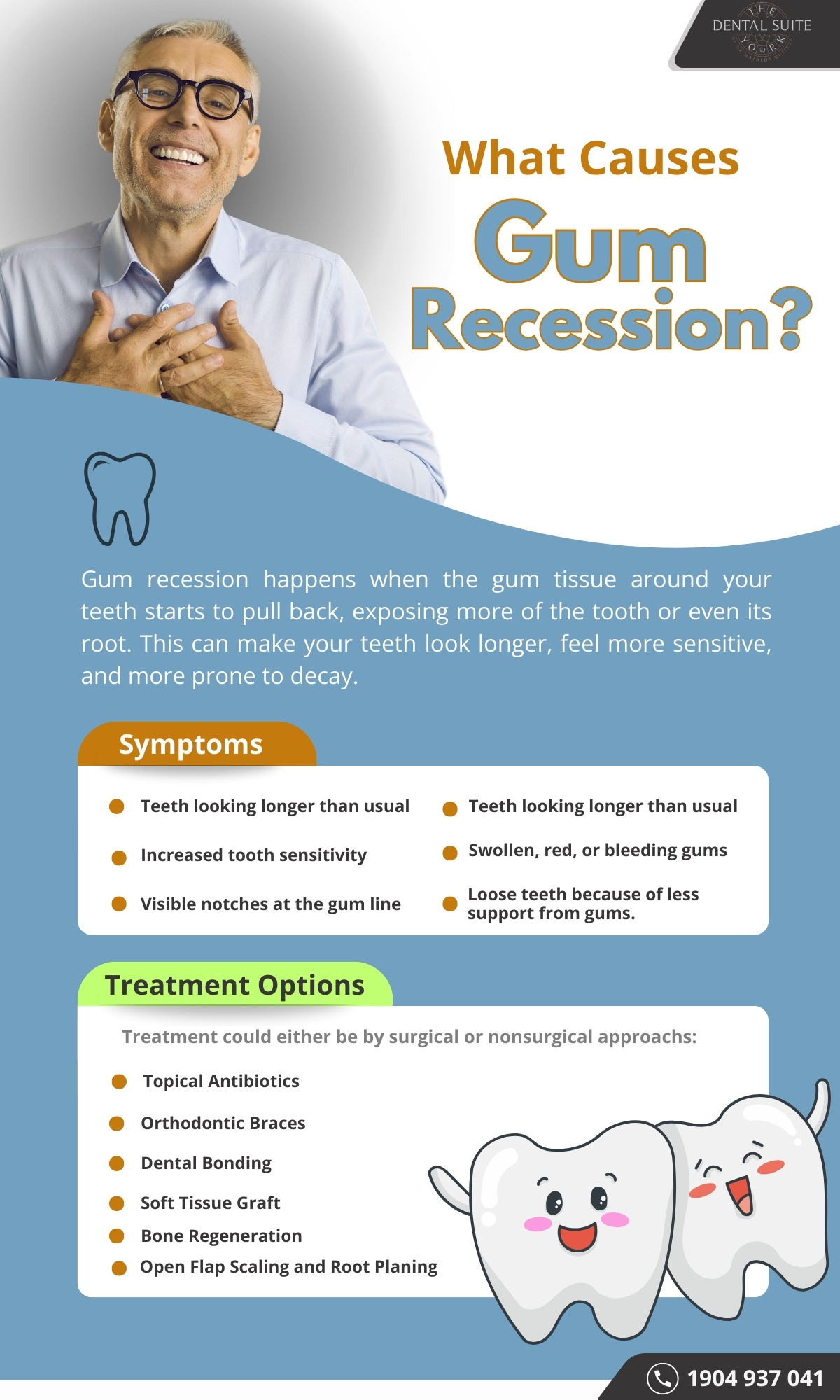22nd January 2025
Gum Recession: Causes, Symptoms, and Treatment Options

Here’s what your cosmetic dentist in York says about gum recession.
Gum recession happens when your gums pull back, exposing the roots of your teeth. It’s not just a cosmetic issue – it can make your teeth more sensitive and vulnerable to damage.
This condition can be caused by things like brushing too hard, gum disease, or even genetics. Treatment can include oral hygiene, medications, and surgical procedures.
In this post, we will take a look at some of the causes of gum recession, its symptoms, and the ways it can be treated to protect your smile.
What Is Gum Recession?
Gum recession happens when the gum tissue around your teeth starts to pull back, exposing more of the tooth or even its root. This can make your teeth look longer, feel more sensitive, and leave them more prone to issues like decay or damage.
While it might seem like a rare problem, gum recession is a common issue, especially as we age or if oral hygiene habits slip. According to the California Dental Association (CDA), approximately 88% of people over the age of 65 have gum recession on one or more teeth.
When it happens, you might notice your gums shrinking, small gaps forming between your teeth, or even some discomfort when eating or drinking.
It’s a gradual process, so it can be easy to miss the early signs. But don’t worry – with the right care and treatment, this can be managed effectively.
Causes of Gum Recession
Gum recession doesn’t just happen overnight. It’s often the result of several factors working together. Let’s take a closer look at some actors that can cause gum recession:
1. Periodontal Disease
This is one of the leading causes of receding gum. Periodontal disease is an infection of the gums caused by bacteria that destroy gum tissue and the bone supporting your teeth.
As the disease progresses, your gums start to pull away, leaving the roots of your teeth exposed. Without treatment, the damage can become severe.
2. Genetic Factors
Sometimes, gum recession is out of your control. If your family has a history of gum problems, you might inherit thin or weak gum tissue, making you more susceptible to recession – even if you take good care of your teeth.
3. Aggressive Tooth Brushing
Brushing too hard or using a stiff-bristled toothbrush can actually harm your gums. Over time, this can wear down the gum tissue, causing it to recede. Remember, brushing is about being thorough, not forceful.
4. Hormonal Changes
Hormonal shifts, especially in women, can make gums more sensitive and prone to problems like recession. Pregnancy, menopause, and even monthly hormonal changes can affect gum health.
5. Insufficient Dental Care
Skipping regular brushing, flossing, or dental check-ups can lead to plaque buildup. If left untreated, plaque hardens into tartar, which can irritate and damage your gums, eventually leading to gum recession.
6. Tobacco Products
Smoking or using other tobacco products is a major risk factor for gum problems. Tobacco reduces blood flow to the gums, making it harder for them to heal and fight infections. Over time, this can cause the gums to recede and leave your teeth more exposed.
7. Crooked or Misaligned Teeth
When teeth aren’t properly aligned, they can put extra pressure on the gums in certain areas. This uneven force can lead to gum tissue breaking down and receding over time.
Contact a cosmetic dentist in York to discuss some orthodontic treatments that can help distribute the pressure more evenly and protect your gums.
8. Grinding and Clenching of Teeth
If you grind or clench your teeth, especially during sleep, you’re putting constant stress on your gums. This can weaken the tissue and cause it to recede. A nightguard or similar solution can protect your teeth and gums from this damage.

What Are Some Symptoms to Look Out for?
Gum recession can creep up on you, so it’s important to know the signs. If you notice any of the following symptoms, it’s time to take action:
- Teeth that look longer than usual: This happens because more of the tooth or root is exposed.
- Increased tooth sensitivity: You may feel discomfort when eating or drinking hot, cold, or sweet foods.
- Visible notches at the gum line: These are signs of gum tissue pulling away from the teeth.
- Loose teeth: As gums recede, they provide less support for your teeth.
- Swollen, red, or bleeding gums: These often indicate inflammation or infection.
- Bad breath or a bad taste in your mouth: This can be caused by bacteria accumulating in receded areas.
When Should I See a Dentist?
If you notice signs of gum recession, it’s important to see a dentist right away. Early treatment can prevent further damage and protect your teeth and gums.
Even if the symptoms seem mild, they can quickly progress without proper care. If you’re looking for expert advice or treatment options, a cosmetic dentist in York can help address gum recession and restore your smile’s health and appearance.
How Is Gum Recession Diagnosed?
Diagnosing gum recession is straightforward and usually done during a routine dental check-up. Your dentist will use a small tool called a periodontal probe to measure the gum tissue around each tooth. This helps determine how much the gums have receded and whether there are deeper issues like bone loss.
Healthy gum pockets are typically 1 to 3 millimeters deep. If the pockets measure 4 millimeters, it may indicate gingivitis. Pockets of 5 millimeters or more usually point to periodontal disease.
By measuring these pockets and assessing your overall gum health, your dentist can create a tailored treatment plan to address the problem effectively.

Treatment Options for Gum Recession
There are two main approaches to treating gum recession: nonsurgical treatments and surgical procedures. The type of treatment depends on the severity of the recession and its underlying cause.
Let’s start with nonsurgical options that can help in less advanced cases.
Nonsurgical Treatments
If gum recession is caused by bacterial infections or gum disease, topical antibiotics can help control the infection. These antibiotics are often applied directly to the affected area in the form of a gel or rinse, reducing harmful bacteria and promoting gum healing.
When misaligned or crooked teeth are putting too much pressure on your gums, orthodontic treatment can be an option. By realigning your teeth, braces or clear aligners like Invisalign can help evenly distribute bite pressure, relieving stress on the gums and preventing further recession.
For cases where exposed tooth roots are causing sensitivity or cosmetic concerns, dental bonding is an effective solution.
This involves applying a tooth-coloured resin to the exposed root, covering it up and protecting it from further damage. It also helps improve the appearance of your smile, making it look natural and healthy again.
These nonsurgical options are effective for managing mild to moderate gum recession, especially when combined with improved oral hygiene and regular dental care.
For more severe cases, surgical options may be necessary to fully address the problem.
Surgical Options
For more advanced cases of gum recession, surgical treatments are often necessary to restore the health and appearance of your gums.
These procedures aim to remove harmful bacteria, repair damage, and even regenerate lost gum and bone tissue. Here are the most common surgical options:
- Open Flap Scaling and Root Planing
This procedure involves carefully folding back the gum tissue to gain access to the roots of the teeth. The dentist removes tartar and bacteria from deep below the gum line, then smooths the tooth roots to help the gums reattach properly.
Afterward, the gum tissue is repositioned and sutured to promote healing and reduce pocket depth.
If gum recession has led to significant bone loss, regeneration may be recommended. During this procedure, the dentist applies a special material to encourage the regrowth of bone and gum tissue.
This could be a bone graft, tissue-stimulating protein, or membrane. This helps rebuild the supporting structures and protects the teeth from further damage.
Soft tissue grafts are used to cover exposed tooth roots and restore the gumline. This involves taking a small amount of tissue from another area, usually the roof of your mouth, and attaching it to the affected site.
The graft not only improves the appearance of your gums but also reduces sensitivity and protects your teeth from decay.
Can I Prevent Gum Recession?
You can take steps to prevent gum recession and keep your smile healthy. It all starts with maintaining good dental hygiene and making smart lifestyle choices. Here’s how you can protect your gums:
- Brush gently and correctly: Brush your teeth with a soft-bristled toothbrush and brush with gentle, circular motions. Avoid aggressive brushing, which can wear down your gums.
- Floss daily: Clean between your teeth to remove plaque and food particles that brushing can’t reach.
- Visit your dentist regularly: Routine check-ups allow your dentist to spot early signs of gum problems and address them before they worsen.
- Treat gum disease early: If you notice red, swollen, or bleeding gums, seek treatment immediately to prevent further damage.
- Use a mouthguard if you grind your teeth: Grinding can weaken your gums over time, but a custom mouthguard can help protect them.
- Quit smoking or using tobacco: Tobacco products can harm your gums and slow their ability to heal.
- Eat a balanced diet: Foods rich in vitamins and minerals, like leafy greens and fruits, promote gum health.

How Can I Reduce Sensitivity Caused by Gum Recession?
Sensitivity from this issue can be uncomfortable, but there are ways to manage it effectively. Start by using toothpaste designed for sensitive teeth, which helps block the pathways that cause discomfort.
Switching to a soft-bristled toothbrush and brushing gently can also prevent further damage to exposed roots. For more advanced cases, treatments like fluoride applications or dental bonding can provide relief and protect your teeth.
If sensitivity persists, it’s important to consult a cosmetic dentist in York. They can assess your situation and recommend tailored solutions, like gum grafting or desensitising treatments, to help you feel more comfortable and protect your smile.
What Is the Best Toothpaste for Gum Recession?
Choosing the right toothpaste can make a big difference when managing gum recession. Like we said earlier, look for toothpaste specifically designed for sensitive teeth.
These types of toothpaste help protect exposed roots and reduces discomfort caused by hot, cold, or sweet foods. Brands that contain fluoride are excellent because they strengthen your enamel and prevent cavities.
Toothpaste with ingredients like stannous fluoride or potassium nitrate is particularly effective in blocking sensitivity and providing long-lasting protection.
Is Gum Recession Curable?
While gum recession itself can’t be reversed, the good news is that it can be effectively managed and treated to prevent further damage.
With proper care and professional treatments, you can restore your gums’ health and protect your teeth. Nonsurgical options like dental bonding or fluoride treatments can reduce sensitivity and protect exposed roots, while surgical procedures like gum grafts can rebuild and reshape your gumline.
The key is catching it early and working with your dentist to find the best solution for your needs.
A Note from the York Dental Suite
Gum recession is a serious issue that requires prompt attention to protect your oral health and preserve your smile. Ignoring the signs can lead to further complications, including tooth loss.
At The York Dental Suite, we’re here to help. Our experienced team offers personalised care and advanced treatments to address gum recession and restore your confidence.
Don’t wait – contact us today to schedule an appointment and take the first step toward healthier gums and a brighter smile.
Call us now on 01904 937 041
Check out this post about Dental implants before you go!